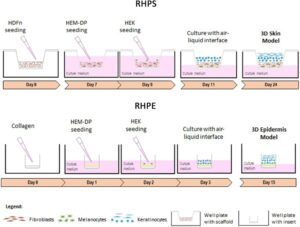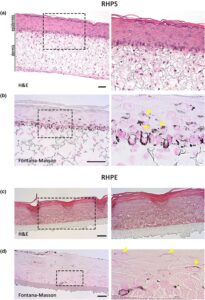
NOVASkin®: 3D Human Skin Models
3D skin models for pigmentation research, drug discovery and preclinical testing that accurately mimic human skin pigmentation and architecture.
BACKGROUND
Skin pigmentation is crucial for protecting against UV radiation, preventing DNA damage and skin cancer. This system relies on melanin produced by melanocytes and transferred to keratinocytes, involving a complex interplay between these cells and dermal fibroblasts. Traditional methods like 2D cultures and skin biopsies fail to replicate skin’s intricate structure and pose significant limitations, including tissue changes and lack of genetic manipulation. Animal models also do not accurately represent human skin pigmentation.
TECHNOLOGY OVERVIEW
NOVASkin® comprises 3D in vitro reconstructed human pigmented epidermis and skin models, reducing the need for animal models and human skin biopsis.
These models consist of (i) an epidermis with melanocytes and keratinocytes, and (ii) a dermis with the epidermis plus fibroblasts embedded in extracellular matrix.
Histology, immunohistochemistry, and microscopy analyses have shown that these models exhibit pigmentation comparable to human skin and a similar melanin transfer process between melanocytes and keratinocytes.
Figure 1: Schematic representation depicting the stages of forming reconstructed human pigmented skin and epidermis. Reconstructed human pigmented skin (RHPS): On day 0, fibroblasts (neonatal human dermal fibroblasts, HDFn) are seeded onto the scaffold to allow the formation of the dermis. On day 7, the formation of the epidermis begins with the addition of melanocytes (human epidermal melanocytes from darkly pigmented skin, HEM-DP), followed by addition of keratinocytes (neonatal human epidermal keratinocytes, HEKn) on the following day. Three days after, apical media is removed to achieve the air-liquid interface and on day 24, the model is fully formed. Reconstructed human pigmented epidermis (RHPE): This model is formed on a collagen-coated membrane to support melanocytes and keratinocytes. On day 1, the melanocytes are seeded, followed by keratinocytes, on the following day. One day after, the air-liquid interface is established and on day 15, the epidermis is completed
Figure 2: Histology of reconstructed human pigmented skin and epidermis models. Reconstructed human pigmented skin (RHPS) (a) and (b), reconstructed human pigmented epidermis (RHPE) (c) and (d). Haematoxylin and eosin (H&E) staining is shown in (a) and (c), and Fontana-Masson staining is shown in (b) and (d) to identify pigment in melanocytes and keratinocytes. Dermis is visible in the skin model and the stratification and differentiation of epidermis are visible in both models. Magnified views of the boxed areas are shown in the right panels. Images are representative of three independent experiments. Arrowheads indicate areas of pigment accumulation in keratinocytes. Scale bars, 50 μm
STAGE OF DEVELOPMENT
TRL 4
APPLICATIONS AND BENEFITS
Ethical Alternative: Eliminates the need for animal testing.
NOVASkin provides a humane alternative to animal testing, aligning with ethical research standards and reducing reliance on animal models. This not only addresses ethical concerns but also adheres to increasing regulatory and societal pressure to minimize animal testing in scientific research.
High Fidelity: Accurately simulates human skin architecture and pigmentation.
These models closely mimic the architecture and pigmentation of human skin, providing a more accurate representation than traditional 2D cultures or animal models. This high level of fidelity ensures that the data and insights obtained from the models are highly relevant to human biology and clinical applications.
Versatility: Suitable for studying a wide range of skin conditions and treatments.
NOVASkin is suitable for studying various skin conditions and treatments, making it a versatile tool in dermatological research. It can be used to investigate skin pigmentation, disease modelling, inflammatory responses, and more, providing a comprehensive platform for diverse research needs.
Customizable: Can be genetically manipulated to model specific skin disorders.
The models can be genetically modified to simulate specific skin disorders or conditions, allowing researchers to explore the molecular mechanisms underlying these conditions. This customization enables targeted studies on rare or complex skin diseases and the development of personalized treatment approaches.
These models allow the complete replacement of animals or skin biopsies for skin pigmentary studies, since they faithfully recapitulate both human skin architecture and pigmentary system. This enables the following range of applications:
- Pharmacological Testing: Ideal for evaluating compounds that modulate skin pigmentation for therapeutic or cosmetic purposes, determining a compound’s effectiveness in changing the epidermal melanin content, by evaluating if they become lighter or darker, and perform melanin quantification, by histology or immunohistochemistry
- Disease Modelling: Enables the simulation of skin pigmentary disorders, including rare conditions like Griscelli syndrome.
- Inflammatory Response Analysis: Assesses potential inflammatory triggers and discovery of anti-inflammatory agents, by quantifying cytokines produced by the cells present in the model. Importantly, this rationale can also be applied to the discovery of anti-inflammatory compounds that can be used in the treatment of disorders such as psoriasis or atopic dermatitis.
- Cutaneous Melanoma Research: Allows the study of cutaneous melanoma progression and other skin cancers.
- Cosmetic and Drug Testing: Serves as a pre-clinical platform for testing cosmetics, drugs, and bioactive compounds for skin application.
INTELLECTUAL PROPERTY
NOVASkin is a NOVA University Lisbon registered trademark.
OPPORTUNITY
NOVASkin welcomes partnerships for contracted research, collaborative R&D initiatives. Each collaboration is tailored to meet the specific objectives and resource considerations of the project. Our commitment to precision, ethical standards, and innovation drives our innovative approach to skin research.
Supported by our experienced scientific and management teams, NOVASkin offers a range of services that includes real-time project monitoring. This direct involvement ensures a transparent process, allowing partners to engage deeply with the research. Comprehensive scientific reports and bespoke data analysis are also part of our offer, providing partners with critical insights for informed decision-making in their research and development ventures.
FURTHER DETAILS
Hall, M.J., Lopes-Ventura, S., Neto, M.V., Charneca, J., Zoio, P., Seabra, M.C., Oliva, A., & Barral, D.C. (2022). Reconstructed human pigmented skin/epidermis models achieve epidermal pigmentation through melanocore transfer. Pigment Cell & Melanoma Res., 35(4), 425–435. https://doi.org/10.1111/pcmr.13039
NOVA Inventors
Duarte Barral
Luís Cabaço
Miguel Seabra
Abel González Oliva





